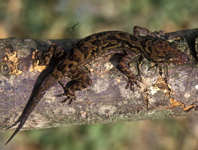Abstract
Ogleus pilarae n. gen., n. sp. (Leptocheliidae) is described from specimens collected at a depth of 28 m off the eastern coast of Puerto Rico. Morphologically the new genus appears to have its closest affinities with the type species of Heterotanais and those of the two subgenera belonging to Pseudonototanais sensu Guţu. Ogleus is distinguished from these and other leptocheliids by a combination of characters including a male antennule having three unfused peduncular articles, five aesthetasc-bearing flagellar articles with the first being greatly reduced and bearing a single cluster of aesthetascs, the shape of the male cheliped, and uropods of both sexes having an elongate endopod with five articles or incipient articles, the distalmost being distinctly longer than the first. The genus Pseudonototanais is rediagnosed to contain P. werthi, P. modestus (female holotype), and with reservations P. bransfieldensis. The Pseudonototanais subgenus Makassaritanais is elevated to full generic rank to contain M. angustus and M. bamberi. The male originally attributed to P. (M.) modestus, does not appear to be a leptocheliid since it has a short uropodal endopod appearing to have just two articles. The taxonomic status of some of the other taxa previously assigned to Pseudonototanais sensu lato or that are superficially similar to it is discussed. Overall, based on the females, the genera Ogleus and Makassaritanais may be more closely allied with genus Leptochelia Dana, 1849 than to Pseudonototanais and Heterotanais. A key to the male leptocheliid taxa having truncated or superficially subchelate-appearing chelae is presented.

